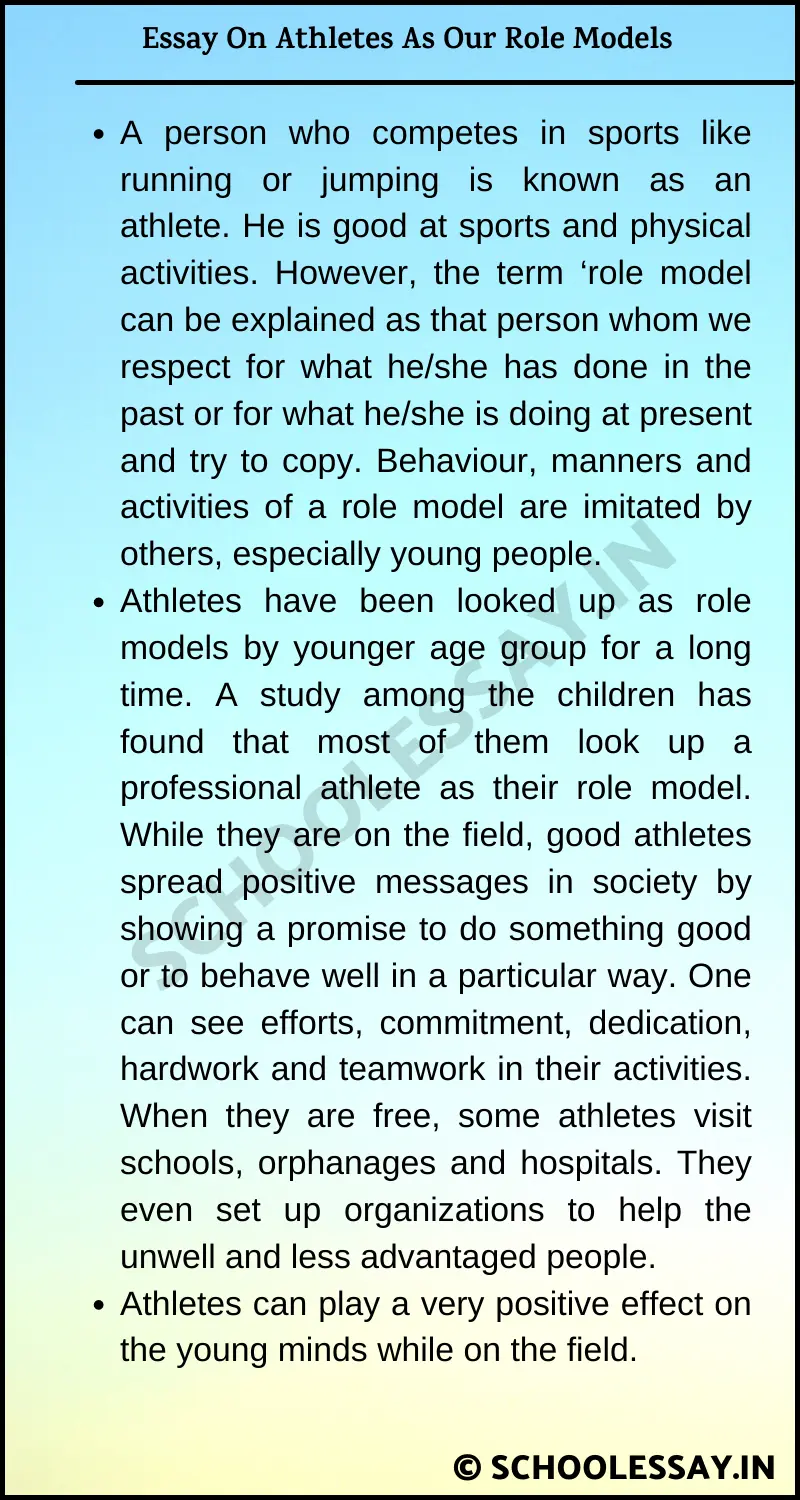Set 1: Essay On Athletes As Our Role Models
A person who competes in sports like running or jumping is known as an athlete. He is good at sports and physical activities. However, the term ‘role model can be explained as that person whom we respect for what he/she has done in the past or for what he/she is doing at present and try to copy. Behaviour, manners and activities of a role model are imitated by others, especially young people.
Athletes have been looked up as role models by younger age group for a long time. A study among the children has found that most of them look up a professional athlete as their role model. While they are on the field, good athletes spread positive messages in society by showing a promise to do something good or to behave well in a particular way. One can see efforts, commitment, dedication, hardwork and teamwork in their activities. When they are free, some athletes visit schools, orphanages and hospitals. They even set up organizations to help the unwell and less advantaged people.
Athletes can play a very positive effect on the young minds while on the field. Players display teamwork in sports such as hockey, football, cricket, baseball, etc. Players work together and all are determined for success. This can be explained through an example. If a young school cricketer watches his favourite national player on television showing strict discipline and self-control, then he too will try to show the same behaviour in his game.
A strong feeling of excitement and interest in something is another important characteristic of athletes. It becomes necessary for the athletes to know that people are supporting them. This can be explained through an example. When a baseball player hits a home run the entire team waits at home plate to praise their fellow player. Even this can be easily imitated by a child watching it in the stadium or at home.
Athlete’s positive effects can also be seen outside the playing field. Professional athletes are well known for doing charity works. There are organizations that help sick children to meet their favourite athlete to spend time with them. This displays an athlete’s kind side towards society. From this, children learn to do something similar for somebody when they grow.
Thus, athletes can be good role models whether they are on the playing field in front huge crowd or off the playing field doing various social activities. An athlete can be an encouraging and inspirational role model.
Set 2: Essay On Athletes As Our Role Models
In today’s world, sport stars and other athletes are looked up to by all ages. Everyone loves them. They look great in the eyes of the everyday public. They appear on television, they perform like rock stars and do this with the entire world watching. No wonder we make heroes out of our favourites.
They are seen as heroes because they can do things that most of us can’t. They hit fastballs at 150 kmph, leap at balls in mid air or defy gravity and throw down a dunk. Their words are repeated and broadcasted throughout the world and their faces have appeared on the front of cereal boxes.
But if you examine athletes while they’re not on the court or on the field, you can see what they are like in every dimension. Athletes have many positive and negative sides that affect their public face and both benefit and harm their abilities to become role models. The athlete as role model is by no means a new issue. In fact it is quite ancient. As distant as 800 B.C., when the Olympics were first played in Greece, the athletes all paid homage to the Greek God Zeus.
Olympia was originally on the sacred site of Gaia. Sports were started as a religious ritual and the athlete was considered a demi-god, representing both the spectator and the gods. In Roman times 2000 years ago, athletes represented the state during the gladiator games and chariot races. They were seen as soldiers who reassured the citizen that the nation was strong.
Today, athletes are not considered to be religious figures but nonetheless are accorded great material wealth, privilege and fame. These figures are visible to us on a weekly basis. Because of their talent, salary and positions as leaders, it’s inevitable that we admire and identify them with such integrity. Courage and determination aren’t the only lessons we can learn from successful athletes. Some of the best athletes in history are the ones who can take their achievements in stride.
You have to love a sport in order to do it well. Hard-working and motivated people understand that winning isn’t everything. Leading a team in homeruns or 3-pointers, is meaningless when compared to one just giving his/hers best shot at it. A champion distance runner says, “Winning is neither everything nor the only thing. It is one of many things.” Athletes have made many contributions to society over the years.
In the past eight years, a famous athlete has raised $1,127,704 for an organisation, which has subsequently blossomed into one of the nation’s leading facilities in helping children with disabilities, mainly Down Syndrome. He said this about the organisation: “I’m very fortunate to be living a dream and making the money I am, so why not give it to someone who really needs it?”
Another athlete founded an eight-month leadership programme designed for high school athletes. The programme involved experiences designed specifically to use as many of the participants’, senses as possible. When they can see it, feel it, hear it, and smell it, then a memory is created and a memory means they’ll have a recall.
Student-athletes involved in the programme participate in police ride-alongs and mock citycouncil meetings, they solve community problems and tutor and coach elementary students.
When we look at athletes, we tend to see that not all that they do is good. Yes, they are supposed to be role models and present the youth with positive vibes. But in reality, they do as much bad as they do good. In the news all the time, we hear about people who are involved in the usage of cocaine. Their actions affect younger student-athletes, specifically in high school.
A survey found that more than 50% of Chicago area student-athletes said that drinking among their peers is a bigger problem than most people realise. Play sports by day, get drunk at night and go to class in the morning. Is this an accurate picture of student-athletes today?.
Student-athletes attend parties, consume some beer and their parents and coaches have no clues about it. Where do the kids get the ‘ok’ to do this? Yes, peer pressure is a problem, but by hearing and seeing professional athletes day in and day out getting in trouble for drugs and alcohol, kids will think it ok.
Although student-athletes are involved in this, some places are doing something about it. Studentathletes will lose their right to play just for being in the presence of alcohol or drugs. As it stands, athletes caught actually drinking or doing drugs face a two-game or two-week suspension from play.
Misbehaviour is always present in sports and fans can be aware of that. But what are the rights and needs of the fans? Should they be mad when they see this misbehaviour? For most fans, their only contract with this will be found in the rules of sports and in fair play on the playing field and by the athlete. Athletes can’t have their cake and eat it too. If they want the love from the fans, then they better not misbehave.
When the media gets involved, some say that they should just report the news. But this is like saying when they score, don’t celebrate. The media can voice their moral position. In doing so, they are very straightforward. The media has an obligation to define issues, report wrongdoing and at times act as a moral barometer for the sport culture.
Star athletes learn from their mistakes as well as from their successes. They have what it takes to be a winner. Top athletes are constantly striving to improve. What’s more, they can stay focussed, often ucy you under intense pressure. To rise to the top, it takes countless hours of practice to fine-tune the skills needed to accomplish your goals. Another major factor that athletes put on society is the strength they show when the odds are against them. For example, Mario Lemieux of the Pittsburgh Penguins. After being diagnosed with cancer, he continued his career in the NHL.
Not only is he one of the greatest to ever play hockey, he’s achieved his goals while missing a respectable amount of games. Another example could be former Olympian Wilma Rudolph. Born with polio, doctors said that it could prevent her from walking. She played basketball and ran track at 13. Positive thinking goes hand and hand with these athletes.
Great athletes can focus on the task at hand. They can become fully focussed and arrive feeling like a winner before they even begin to compete. Athletes who are champions also show qualities such as perseverance, dedication and the ability to keep their cool under pressure. Stories about superstar athletes teach us about working hard and believing in ourselves and being passionate about what we do.
Many high-profile players work hard to be positive role models to children. In addition, they raise money for charities and act as mentors, talking to groups and volunteering their time to programmes that help kids stay away from drugs and alcohol. They get paid vast sums for their efforts and their names and faces appear on everything from running shoes to billboards.
Still, even the greatest champions have flaws, Just because someone has a perfect swing it doesn’t mean that he’s a good friend, parent or spokesperson. Just because they’re rich and famous doesn’t mean they don’t face problems like the rest of us do. Just because they have such an image doesn’t mean that they don’t get sick and have to stay in bed. However, separating an athlete’s professional and personal life can be quite difficult.
Fans do get disappointed when athletes get in trouble with the law or make crucial mistakes in their personal lives. Before he died, the great Mickey Mantle, who was a raging alcoholic, told young ball players, “Play like me, don’t be like me.” As these stories arrive, questions form in the minds of fans across the country. Who are athletes really role models for?
In conclusion, athletes inspire and encourage as well as bring upon a bad influence on society today. They know what they are in the spotlight to do and by all means they accomplish it. Good and bad come out of sports and with today’s media, it’s swallowed up and spit out in many different forms. Everyone out there is watching and for a prime time athlete, every decision is monitored. The athlete as a role model is not an issue, it’s a part of everyday life.

ALSO READ:
- Essay On Arundhati Roy
- Essay On Artificial Satellites And Their Types
- Essay On An Hour at a Jeweller’s Shop
- Essay On An Hour at a Polling Station
- Essay On An Hour in a Cloth Shop
- Essay On An Hour In a Public Garden
- Essay On An Hour Standing at a Theatre
- Essay On An Hour at a Variety Entertainment Show
- Essay On An Hour at a School Laboratory
- Essay On An Hour at a Bus-Stop

